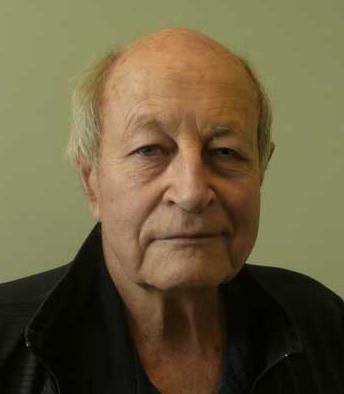MRM Life Membership for Stuart Hayman

Stuart Hayman, who has been a consultant on technical issues to NZMRM since leaving Gerard Roofs in 2009, was made a Life Member at its September conference in Noosa.
Stuart has been involved on many projects of technical significance to the roofing industry - from standards to noise testing, light v’s heavy weight roofing, durability issues to roofing underlay.
A chemist by profession, Stuart worked in the paper and porous plastics industries before immigrating to New Zealand in 1975. He worked in the technical and engineering side of Alex Harvey Industries, including building and equipping the George and Ashton container factory in Dunedin, then becoming manufacturing manager at AHI Armafoil (foils and underlay) in 1978 and later at AHI Roofing (metal tiles, now Gerard Roofs) from 1984 – 1996 when his role there became technical development manager from 1996 to 2009.
The 12 years between 1984 and 1996 involved interesting technical and product development work as well as running the factory. AHI Roofing’s global activities meant visits to European licensees, working to commission the factory in Algeria, approving the site for the Californian plant, and later involvement in product development and commissioning there. The acquisition of the Rolls Gerard Papakura plant meant organising production of the Gerard products at Glen Innes. A visit to the Indonesian Gerard licensee showed how you can actually make products more or less by hand.
After 2000 he visited the Argentinean agent, the Malaysian plant and did product testing in Australia (including product testing for exposure to fruit bat droppings!)
So this was an interesting time to be in the business.
From about 2000 on he became increasingly involved in NZMRM technical projects. Involvement with NZMRM started really with sitting on the NZS 3604 standards committee in 1999. He has been a member of the NZMRM Executive committee since then, first representing Gerard Roofs and then as a co-opted member.
Stuart has been closely involved with the Code of Practice from its inception in 2002 and which is currently being completely revised to be published on the internet rather than as a continuous document as it is currently. The CoP is being organised to align with the NZ Building Code clauses, involving significant re-organisation of material along with updating and revising in line with changes in regulation and knowledge.
Stuart has represented MRM on;
- New Zealand and Australian standards, notably NZS 3604 1999/2000 (and again in 2011),AS/NZS 2728 and AS/NZS 4505, along with NZS 2295in 2006 and
- again now and, AS/NZS 4200 and AS 1562.1 currently. NZMRM
- is a regular member of Australian committees BD-014 (Roof cladding and testing),
- BD-058 (Underlays and insulation) and MT-009 (Metal treatment) and is currently representee
- Stuart (and David Eccles-Hall of RANZ) are currently representatives on SNZ committee P2295 revising NZS 2295 – Pliable, Permeable Building underlays. RANZ technical chairman, David Eccleshall represents RANZ on NZS 2295.
He has been closely involved with two major (long-term) technical projects for MRM, the corrosion project and the wind load test rig.
The roofing industry had been aware during the 2000s of some incompatibility between fasteners and cladding, manifesting in differential corrosion.
In 2012 MRM commenced a programme to investigate the relationship between fasteners and cladding in severe environments.
The aim of this scheme, developed initially by the late Stuart Thomson, was to optimise products used together and to promote development of improved durability of fasteners. Roof panels of all currently available metal cladding with all currently available fasteners were located at five marine sites around New Zealand, the locations characterised for corrosivity according to ISO 9223 and the cladding/fasteners inspected at regular intervals.
After four years the efforts are now concentrated on two West Coast sites and incorporate other product interactions and new products are also being assessed on these sites.
Stuart has also been involved with MRM’s wind load test rig, acquired in 2006 to simulate and assess the effect of wind uplift on roof cladding and fixing patterns and he currently manages the testing programme for members and for NZMRM.
The rig is described as an air box and is one of only a few in Australasia. Cladding is fixed to the top of an airtight steel box and the purlin spacing and fastening pattern varied. The box is pressurised with a fan and the effect on the cladding (damage and deflection) at increasing pressures documented. This information enables a load span graph to be produced for any particular cladding profile and fixing method. In the last couple of years MRM has re-tested standard profiles in steel and aluminium in order to update the data published in the Code of Practice.
Stuart has also been involved in the Sustainability sub-committee which promotes the environmental benefits of metal cladding. This has recently been involved in the “zinc runoff” project, also reported in Scope, and which is an ongoing issue.
In addition Stuart has carried out a number of other projects, many of which have been reported in Scope and Rooflink. To name a few; traffic noise through roofs, the use and fixing methods of solar panels, the viability of solar energy, reflectivity of metal and painted surfaces, the Auckland Unitary plan submissions, the effect of heavy metals and water collection, roof valley drainage.....and the list goes on. The body of work and expertise behind the scenes and published that Stuart has given to the industry is expansive. (These reports are all available on the NZMRM website).
NZMRM runs a number of both one-off and ongoing technical based projects and Stuart has been involved in many of these, either hands-on or management, and we try to keep members and interested parties up-to-date on these through reports in Scope, all of which are now archived and available via the NZMRM website.
